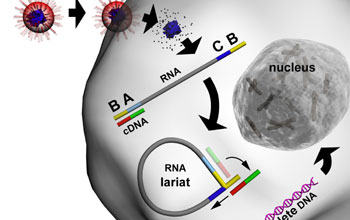All Images
Research News
RNA Lariat May Tie Up Loose Ends to Decades-Old Mystery of Retrovirus Life Cycle

The RNA lariat structure identified by Tom Menees at the University of Missouri-Kansas City may fill a key gap in the process by which retroviruses infect cells. Here, a virus is shown infecting a cell. The viral RNA, which contains the virus's genetic code, must then be converted to DNA. This process begins when the virus transcribes segments A and B of its RNA into complementary DNA (cDNA). Upon reaching the end of the RNA strand, the partially built cDNA must then jump to the other end of the strand (segments C and B) to continue; how this jump occurs has been a mystery. Though it still must be confirmed by further research, the RNA lariat structure may solve the problem by juxtaposing the duplicate B segments and allowing the partial cDNA to switch to the C-B end. A host-cell enzyme (called Dbr1) then breaks the lariat so the cDNA assembly can continue. Once completed, the double-stranded DNA inserts into the host chromosomes in the cell's nucleus where the cellular machinery is used to manufacture new copies of the virus.
Credit: Trent Schindler, National Science Foundation
Download the high-resolution JPG version of the image. (393 KB)
Use your mouse to right-click (Mac users may need to Ctrl-click) the link above and choose the option that will save the file or target to your computer.


